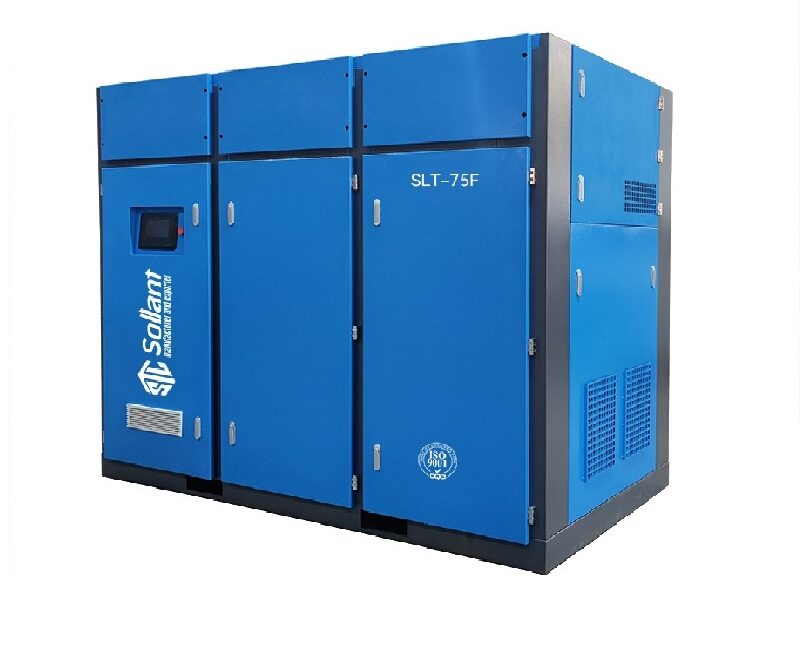The purpose of the Sollant air compressor control system is to match the demand and supply of compressed air most efficiently. While old-fashioned electropneumatic controls are being replaced by microprocessor-based controls with optimized systems and software upgrades for control parameters, any type of control is either fixed-speed or variable-speed control.
-
Fixed speed air compressor control
As the name implies, this method is to keep the speed of the air compressor constant. The specific speed is determined by the speed of the drive motor and the transmission ratio function of the transmission. The transmission can be a gear or a V-belt port, and the air volume control is based on modulation control or poppet control.
-
modulation control
This form of control adjusts the intake valve of the air compressor according to the discharge pressure of the air compressor. When the controller detects that the exhaust pressure has risen, it starts to close the intake valve. While this control is effective, it is the least efficient. The reason is that the efficiency of an air compressor is inversely proportional to the pressure ratio, which is the ratio of the exhaust pressure to the intake pressure. The closed intake valve creates a vacuum at the inlet of the air compressor, while the exhaust pressure remains relatively unchanged, which is equivalent to increasing the pressure ratio.
The remedy is to limit the adjustment range of the modulating control to approximately 40%, and automatically switch the control scheme to load/no-load control once the output drops below 60%. Unfortunately, this control cannot be applied to multiple machines.
-
Shift and control
Controlling the effective rotor length can change the displacement of the air compressor. It is mainly achieved by adding a cone valve or a screw valve to the main engine to control the internal bypass. Although the efficiency of this control is better than modulating control, the screw valve control is only effective above 50% to 60% capacity, and the debugging of this control is complicated and difficult.

-
unloading/load control
This control is simple and effective, using the pressure rise and close at the exhaust of the air compressor to completely close the intake valve when the upper limit (disconnect) pressure is reached, and fully open the intake valve when the lower limit (connection) pressure is reached. The difference with modulation control is that the air compressor under this control implements internal unloading. A decrease in pressure ratio leads to a decrease in idle work consumption. This type of control enables easy connection of multiple air compressor units using a sequencer (master) controller. Air systems, on the other hand, require a properly sized air storage tank to be installed.
-
start/stop control
This is the most effective control scheme. The air compressor is either running at full load or shutting down, depending on the signal port at the pressure switch. It can be borrowed that if the motor above 10hp is often started and shut down according to the requirements of this control, it will cause overheating. This control is often used in small piston air compressors with accumulators installed. The differential pressure of this air compressor is relatively large, which can reach 15 psig to 25 psig.
-
variable speed control
Advanced and economical technology brings variable frequency drive technology to air compressor applications. The principle seems simple, that is, to precisely control the speed of the air compressor/motor according to the system requirements. If properly designed, frequency conversion control is the most advanced and energy-saving air compressor control port. However, some of the following problems must be solved.
The main engine of the air compressor should be designed to have high efficiency in the whole speed range. The efficiency of the main engine is a function of the linear speed of the rotor addendum, and it may drop significantly when the speed is too low or too high.

The variable speed drive controller must be sufficiently efficient as an additional link between the power supply and the drive motor. Drive systems and motor electrical performance must be free from electrical distortion and electromagnetic radiation that could interfere with computers or other sensitive electronic equipment. Drive motors must be as efficient at high speeds as they are at low speeds, where bearing design and cooling issues can be troublesome. The intelligent controller establishes an efficient and reliable connection between the air pressure, the electric motor and the intake valve of the air compressor.
A well-designed device can accurately control the discharge pressure of the air compressor within 1 Psi, although the air demand fluctuates widely. Variable speed control is suitable for adjusting the operation of multiple air compressors. It allows the sequencer/controller to operate efficiently in parallel air compressors. According to demand, some air compressors run at full load, and the rest of the air compressors are on standby. Variable speed control can Effectively make up for the fluctuation of gas demand.
However, even the most efficient controls cannot compensate for poor system design. Give the air system a complete system check and give the control system the opportunity to realize efficiency improvements.
Sollant Focus on Energy Saving.



